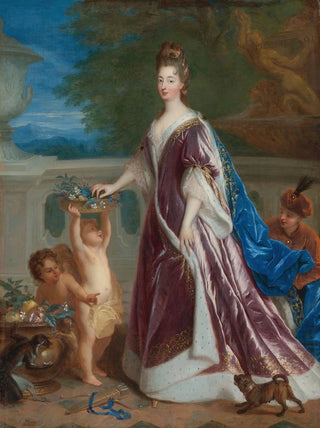Art print | Portrait of Elisabeth Charlotte of Bavaria, Palatine princess - Jean-François de Troy


View from behind

Frame (optional)
In the rich panorama of 18th-century French painting, the "Art print of Elisabeth Charlotte of Bavaria, Palatine Princess" by Jean-François de Troy stands out for its elegance and charm. This painting, which captures the very essence of European nobility, offers a fascinating glimpse into life at the French court. Elisabeth Charlotte, granddaughter of Philip I of France, embodies through this portrait the aspirations, intrigues, and alliances that marked her era. The delicacy of her features and the finesse of the details testify to an artistic mastery that goes beyond mere representation, inviting the viewer to immerse themselves in the refined universe of the court.
Style and uniqueness of the work
Jean-François de Troy's style is characterized by an approach that is both realistic and idealized, where each element of the painting contributes to an atmosphere of serenity and majesty. In this portrait, the princess is depicted with captivating grace, dressed in sumptuous attire that highlights her high status. The colors, subtly chosen, oscillate between soft tones and more vivid shades, creating a harmonious contrast that draws the eye. The meticulous details, such as the embroidery on her dress and the ornaments in her hair, reveal the artist's craftsmanship and his ability to breathe life into his subjects. This painting is not just a simple image; it tells a story, that of a strong and influential woman, while celebrating the beauty and refinement of her time.
The artist and his influence
Jean-François de Troy, born in 1679, is one of the most emblematic painters of his time. Trained in his father's workshop, also a painter, he developed a style that combines classical influences with modern sensitivity. De Troy established himself as a preferred portraitist, attracting the attention of nobles and court members. His ability to capture the personality of his models, while maintaining a certain aristocratic distance, marked his work and influenced many artists of the period. As

Matte finish

View from behind

Frame (optional)
In the rich panorama of 18th-century French painting, the "Art print of Elisabeth Charlotte of Bavaria, Palatine Princess" by Jean-François de Troy stands out for its elegance and charm. This painting, which captures the very essence of European nobility, offers a fascinating glimpse into life at the French court. Elisabeth Charlotte, granddaughter of Philip I of France, embodies through this portrait the aspirations, intrigues, and alliances that marked her era. The delicacy of her features and the finesse of the details testify to an artistic mastery that goes beyond mere representation, inviting the viewer to immerse themselves in the refined universe of the court.
Style and uniqueness of the work
Jean-François de Troy's style is characterized by an approach that is both realistic and idealized, where each element of the painting contributes to an atmosphere of serenity and majesty. In this portrait, the princess is depicted with captivating grace, dressed in sumptuous attire that highlights her high status. The colors, subtly chosen, oscillate between soft tones and more vivid shades, creating a harmonious contrast that draws the eye. The meticulous details, such as the embroidery on her dress and the ornaments in her hair, reveal the artist's craftsmanship and his ability to breathe life into his subjects. This painting is not just a simple image; it tells a story, that of a strong and influential woman, while celebrating the beauty and refinement of her time.
The artist and his influence
Jean-François de Troy, born in 1679, is one of the most emblematic painters of his time. Trained in his father's workshop, also a painter, he developed a style that combines classical influences with modern sensitivity. De Troy established himself as a preferred portraitist, attracting the attention of nobles and court members. His ability to capture the personality of his models, while maintaining a certain aristocratic distance, marked his work and influenced many artists of the period. As






